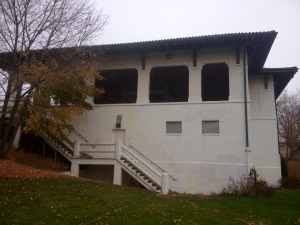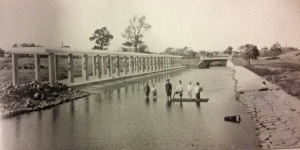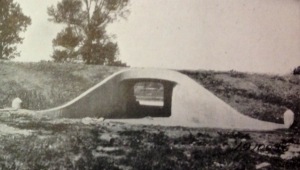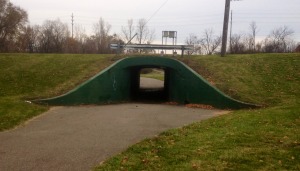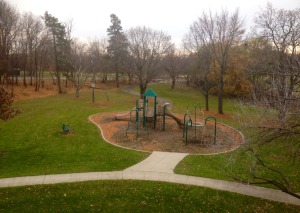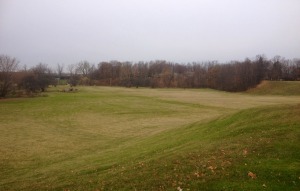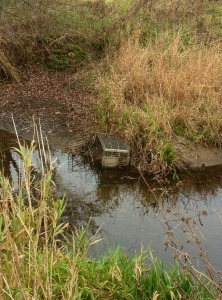Map shows plans for expanding the existing Kearsley Park, per the City Plan Commision’s report of 1920.
(Photo by Wallee Keating)
The still standing (and many times repainted) Head House.
“Every winter they did a tree burning, so when you were done with your Christmas tree, it was this big tradition for everybody to bring their trees down to Kearsley Park, and in the middle of the winter they’d have this big bonfire burning all the Christmas trees, so it was just a way for people to get out in the wintertime and enjoy it.”
– M. Fox
Kearsley Park was established in 1917 after a real estate and insurance firm donated the 60-acre stretch of land along Gilky Creek to the city. At the time, this was the largest piece of property that the city actually owned. Following construction of an open air swimming pool in 1920, the Head House (more commonly known as the Pavilion) was built.
On August 2, 1928 125,000 people gathered in Kearsley Park to celebrate the 25th anniversary of Buick Motor Company and the beginning of the automotive industry in Flint. The Flint Journal called it the “greatest birthday party ever held in Flint, and probably in the US.” At the time, Flint’s population was 149,000 people, so most of the town’s population was in attendance for the free food and beverages provided by Buick.
By the 1950’s the park contained not only the pool and Pavilion (used as a skating rink in the winter time), but a supervised playground, youth center, picnic grove, baseball diamond, tennis courts, parade grounds, an iris garden, wading pool, coasting area, underpass, volleyball, and toboggan shoot.
(Photos from the UM-Flint Genesee Historical Collections Center)
The underpass and wading pool, circa 1920.
(Photo by Wallee Keating)
The underpass, circa 2014.
“The coolest thing about this city as a child is that we had Safetyville. Safetyville was really cool because they had go-carts, and everybody could go down there and at the age of ten you could get a driver’s license and drive the go-carts, but you had to know all your signs like a stop sign and yield sign and all that. They built up a little city, they had little wood houses, they had a business, they had a police station, a fire station. And so they had this big track where you drove your little go-cart around, and it was called Safetyville, and those cars are actually in the Sloan museum now.”
– M. Fox
In 1963 Kearsley Park debuted two new playground structures (Kearsley Park Playland and Kiddieland Junior), as well as the now renowned Safetyville. The 30,000 square foot miniature town opened thanks to a grant from Flint’s Industrial Mutual Association. Children could drive 12 miniature replicas of Corvettes and other GM vehicles around the small town, if they knew the rules of the road and were able to obtain a driver’s license.
Until 1970, an annual “Burning of the Greens” celebration was held twelve nights after Christmas, during which community members could discard and burn their Christmas trees. The practice was ended due to concerns about pollution.
Beginning in 1972, Safetyville began to close off and on due to vandalism and city budget cuts. The miniature town was finally torn down in 1981. For similar reasons, the swimming pool was removed in 1984.
(Photo by Wallee Keating)
Now a playground sits in the area of the former swimming pool.
“I remember Buick’s fiftieth year, I want to say it was 1972, I don’t know why that is ringing a bell, but they – their fireworks were bigger than any fireworks presentation I’ve ever seen, and they did it out of Kearsley Park, it was a fiftieth year celebration of Buick and it was phenomenal.”
– M. Fox
Kearsley Park also used to be home to Flint’s annual 4th of July fireworks celebration. Since the 1980s, there have been many community efforts to clean up and maintain the now poorly funded park.
(Photo by Wallee Keating)
Kearsley Park now mainly consists of large open spaces, and sees fewer visitors. In the winter, children can still be found sledding on this hill.
(Photo by Wallee Keating)
Efforts to keep the park clean are not always 100% successful.
Kearsley Park has been home to the Kearsley Park Players since 2005, which annually produces Shakespeare in the Park and puts on several plays a year in the Pavilion.
Historical information and photographs were obtained from the Genesee Historical Collections Center, a division of the University of Michigan-Flint Thompson Library.
Nolen, J. (1920). The city plan of Flint, Michigan: including the reports of John Nolen, city planner, and Bion J. Arnold, transportation engineer, as approved by the City planning board and accepted by the Common council. George C. Kellar, mayor. Frank D. King, city clerk. [Flint: Flint printing co.,].
About the Kearsley Park Players. (2013, January 1). Retrieved November 9, 2014, from http://www.kearsleyparkplayers.com/resume.html
Please leave a comment below to share your story! If you are interested in being interviewed and having your story added to this page, visit the following link for more information: Share Your Story

